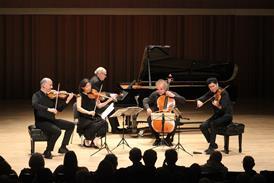The development of the great violinists from fresh young artists to profound musical thinkers can be charted through their recorded interpretations. Nathaniel Vallois uses his time in lockdown to examine changes in the playing style of some of the best-known names

The following is an extract from an article in The Strad’s December 2020 ‘Willemotte’ Stradivari issue. To read in full, click here to subscribe and login. The December 2020 digital magazine and print edition are on sale now.
Discover more Featured Stories like this in The Strad Playing Hub
Unlike Heifetz, Nathan Milstein built his career around a relatively narrow body of works but obsessively varied the detail of his interpretations. The many recorded performances of his core repertoire shed light on his ceaseless search for fresh possibilities, his reservoir of fingerings seemingly inexhaustible. His discography of unaccompanied Bach spanning half a century (1936–86) chronicles an evolving approach that was well ahead of that of his peers. While his assertion that the later of his two complete cycles (1954–5 and 1973) was much superior is debatable (both are exceptional), he did gradually move closer to the manuscript, explore the dance forms further and generally adopt a somewhat more intellectual stance.
Overall, an ever deeper concern for pure resonance and simplicity of line often characterised his later playing, which was supremely accomplished in his 1961 Beethoven Violin Concerto with Leinsdorf but equally in his own miniature arrangements. Listening to his various interpretations of, for instance, Mendelssohn’s and Goldmark’s concertos, one is struck by how sentiment becomes increasingly understated, as if not to get in the way of the purest distillation of the music, yet somehow at no loss of charisma. Asked by Pinchas Zukerman in the Christopher Nupen documentary Nathan Milstein, Master of Invention (1992) what he thought of as he started Bach’s G minor Siciliana, he memorably replied ‘I just try not to spoil it.’
Read: Evolving interpretations: The long and winding road
Read: How did Jascha Heifetz’s interpretations evolve over his lifetime?
Discover more Featured Stories like this in The Strad Playing Hub
-
This article was published in the December 2020 ‘Willemotte’ Stradivari issue
The late-period violin’s strong personality is the perfect match for its current owner Leonidas Kavakos. Explore all the articles in this issue. Explore all the articles in this issue
More from this issue…
- The 1734 ‘Willemotte’ Stradivari violin
- A newly discovered Vieuxtemps cadenza
- Coaching chamber music for school-age students
- Amandine Beyer on recording C.P.E. Bach’s string symphonies
- The history of the viola d’amore
- Evolving interpretations of the great vioinists
Read more playing content here
Topics
Bach Solo Violin Sonatas: At heart a fugue
- 1
- 2
- 3
- 4
- 5
- 6
- 7
- 8
- 9
- 10
- 11
 Currently reading
Currently reading‘I just try not to spoil it’ – Nathan Milstein on Bach
- 12
- 13
- 14
- 15

















































No comments yet